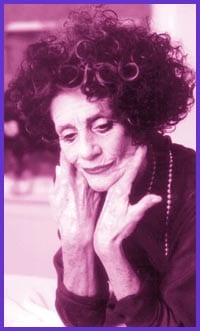The world of Colette is a sissy’s paradise.
Every bowl is crystal and holds a rose. The air is thick with lily of the valley perfume. Paper fans flutter against dewy breasts. You are never too far from a pair of dainty slippers à la chinoise. And that man dropping his calling card in your porter’s palm has just freshened his wolfish beard with brilliantine.
Is that gay enough for you?
When Paul Bettis, Toronto’s doyenne of experimental theatre, announced his intentions to stage Colette’s Chéri novels (Chéri, published in 1920, and The Last Of Chéri, published in 1926), I became affectionately dizzy at the promise of seeing Colette’s rowdy portrait of turn-of-the-century Parisian whore culture brought to life.
Thank God Livent didn’t get the rights first, as Bettis is the perfect artist for the material. (In fact, this adaptation is the first licensed by the Colette estate in decades.) Always a bit of a charming nutter (on and off stage), Bettis thrives in intellectual hothouses where sex, philosophy, and incessantly wagging tongues bear the juiciest, if most twisted, fruit.
For instance, Bettis’s last play, The Freud Project, was all about the origins of psychoanalysis (no small subject). Then he acted in Wallace Shawn’s jaw breaking yak-fest The Designated Mourner, followed by Sky Gilbert’s revisionist queer history play Schubert Lied (which earned Bettis a Dora nomination).
Clearly, Bettis is primed for Colette’s psycho-sexually loaded material – and the story of Chéri is an Oedipal maze.
Chéri is a spoiled mamma’s boy raised by a coven of rich, decadent courtesans. Especially attentive is the worldly Lea, une femme d’une age certaine, to whom Chéri becomes addicted. When Chéri reaches manhood, he consents to a loveless marriage with the conveniently wealthy Edmee; thus replicating the mercenary, soul-chewing choices made by his mother. His decision, of course, drives the bratty Chéri into an opium-sotted vertigo.
Gay enough indeed!
Colette’s heady, detail-obsessed prose seems an unlikely choice for a stage adaptation, but Bettis is keen to stress the narrative line underneath all that gauze and plumage.
“The Chéri novels adapted very smoothly,” Bettis explains. “Partly because there are very strong stories, perfectly set scenes, and the dialogue is so compact.
“Ultimately, Chéri is a conversation piece, a play about human relations, love, money and growing old.”
And, of course, it’s about a beautiful boy.
“Oh yes. The primal image, if you will, the main theme, is the situation, the vision, of a beautiful boy preyed upon by a bunch of older women. It’s a timeless scenario and it rings lots of ancient, mythological bells. Chéri is, psychologically, if not literally, torn apart.”
Bettis believes that Colette’s Chéri novels are as much about the author’s confronting of her own May/December desires as they are recreations of the woman-to-boy taboo – a subtle distinction largely lost on Colette’s audience of the 1920s, who read the books for scandal and titillation, not introspection.
“In the novels, female love for young boys must be renounced. But it is done with great sadness. And that works as a marvelous tension in the play.
“Besides,” Bettis adds with a sneaky chuckle, “being gay, I don’t mind at all doing a play that allows for the enjoyment of watching a young, beautiful man being hard used.”
When I ask Bettis if the novels’ depictions of unconventional romance can be read as a stand-in for queer romance, he quickly points out that the term “unconventional” is a hall of mirrors.
“The relationships are not all that unconventional, within the world in which the characters live. In fact, in their milieu, things the outside world sees as different or radical are actually both eternal and mundane. Remember that these people had a respectability all their own. They were very high class pimps, courtesans, and madames working in a grand style. It’s a lost world Colette is depicting – but not a low one. “
But isn’t any demimonde, no matter how heterosexual, always a parallel to queer life?
“Well, we all live by some sort of projection, don’t we? Gay men always seem to squeeze themselves in wherever they go.”
Finally, I ask Bettis which character is the most like him. I’m surprised to learn it is Lea, Chéri’s surrogate mother. “The novel firmly puts you in Lea’s point of view. Colette makes you see the boy through loving, erotic, yet also maternal eyes. It’s a very complex gaze. So, you can’t help loving the boy.”


 Why you can trust Xtra
Why you can trust Xtra


